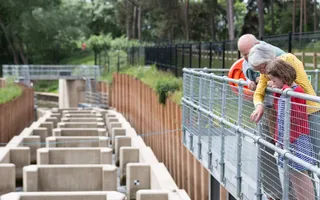Diglis Island sits in the River Severn downstream from the centre of Worcester. Once it was home to a lock gate making workshop, lock keeper and toll keeper who would manage shipping through the vast river locks to bypass Diglis weir.
The weir made the river navigable by forming a block that kept water levels upstream higher than normal. Once a vital part of river trade the weir still stands as testiment to the large engineering projects of the Victorian Era.
Today the workshops have been transformed into community and learning spaces with schools visiting to learn all about about the fish pass and migratory fish, the history of this island and its importance to Worcester and the River Severn.
A historic barrier for wildlife
The River Severn is home to many species. River corridors provide habitats through the landscape and safe spaces away from human activity so that wildlife can thrive.
For more than a hundred years the Diglis weir had blocked the path of migrating fish trying to access their ancestral spawning grounds in the top reaches of the river.
A multi million pound project has seen one of the largest fish passes in the world built to bypass the weir and allow migrating fish access further upstream than had been seen since the Industrial Revolution.
The Diglis Fish pass provides a window under the water to see these fish on their journey and learn about the biodiversity present in the UK's longest river.









